PSYC2050
1/75
Earn XP
Description and Tags
Flashcards for the majority of lecture content in PSYC2050
Name | Mastery | Learn | Test | Matching | Spaced |
|---|
No study sessions yet.
76 Terms
Lecture 1
What is learning?
A fundamental, adaptive process in living animals where the tendency to perform a specific behaviour, emotion and / or thought is changed by experience
The learning must be lasting (experience & practice helps reinforce and make it last longer)
Lecture 1
What is experience?
Any information of our environment that can be detected by our sensory systems
Lecture 1
What is habituation (non-associative)?
Habituation is a ‘getting used to it’ response, whereby an organism naturally becomes used to a novel stimulus overtime e.g. becoming used to a loud noise outside whilst studying
An orientating response may initally be displayed e.g. turning our head to look at the stimulus, but after prolonged exposure we learn that this is not significant because there is no need to be distracted by it.
This is when habituation has taken place.
Habituation is the simplest form of learning found in nearly every animal
Lecture 1
What is sensitisation (non-associative)?
Lecture 1
What is associative learning?
Forming connections between stimuli
As a child in QLD, you were told to avoid leaf piles as snakes like to nest in them. However, when moving to the UK, the connection and fear of leaf piles remains as the association between leaves and snakes is still attached.
Lecture 1
What is cognitive psychology?
The study of mental processes such as perceiving, attending, remembering and reasoning
Lecture 1
What is low cognition?
Reliant on our senses and environment only (vision, hearing etc.)
Lecture 1
What is high cognition?
Abstract, mental representations derived from individual experience
Lecture 2
What are the two different types of associative learning?
Classical Conditioning
Operant Conditioning
Lecture 2
Define Classical Conditioning
Classical conditioning refers to learning that occurs when a neutral stimulus (e.g., a tone) becomes associated with a stimulus (e.g., food) that naturally produces a behaviour.
After the association is learned, the previously neutral stimulus is sufficient to produce the behaviour.
Lecture 2
Explain Ivan Pavlov’s dog experiment
Certain stimuli elicits a response: Give a dog food → innate response is to salivate
Other stimuli don’t elicit response: Blow a whislte at dog → no salivation
However, when pairing the food and whistle together, the dog learns the association, thus salivating at only the sound of a whistle
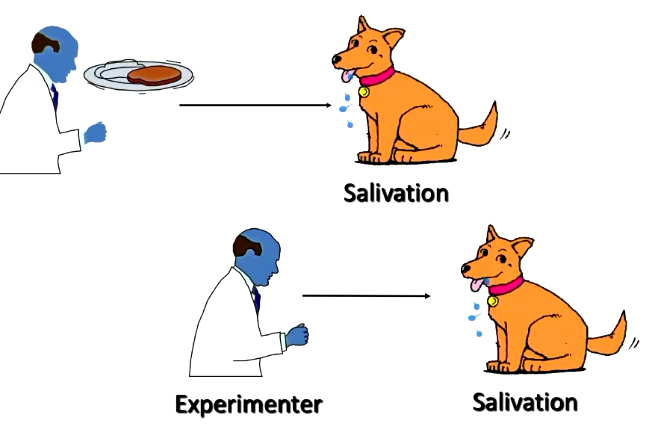
Lecture 2
What are the 4 elements of classical conditioning?
Unconditioned Stimulus (US)
Unconditioned Response (UR)
Conditioned Stimulus (CS)
Conditioned Response (CR)
Lecture 2
What is an Unconditioned Stimulus (US)?
A stimulus that elicits an unlearned response
e.g. Food elicits salivation
Lecture 2
What is an Unconditioned Response (UR)?
The unlearned response to the US
e.g. Dog salivating at food
Lecture 2
What is an Conditioned Stimulus (CS)?
A stimulus to which an organism must learn to respond
e.g. Whistle
Lecture 2
What is an Conditioned Response (CR)?
The response to a CS (which is learned)
e.g. Dog salivating at sound of whistle
Lecture 2
Explain the Little Albert experiment (Watson & Rayner, 1920)
A loud noise was made around Little Albert (US), making him cry (UR)
In further trials, the researchers then paired the loud noise with seeing a white mouse (CS)
When Little Albert saw only the white mouse (with no loud noise), he cried (CR)
This lead to a generalised fear in Little Albert, whereby similar characteristics to the white mouse would cause him to cry e.g. a white rabbit, a fluffy white beard etc.
Lecture 2
Give another example of Classical Conditioning (not including Pavlov’s Dogs or Little Albert)
Similar examples of Classical Conditioning include:
Clinical Applications
Acquisition of fears, phobias, and other maladaptive behaviours
E.g. having a phobia of leaf piles since snakes could be hiding in it, but still being scared when moving to the UK, where this phobia doesn’t make sense (the association between leaves and snakes is still attached)
Treatment required such as flooding
Eyeblink Conditioning
Blowing a puff of air into a human eye causes us to naturally blink. However, if a tone is played prior to the air puff, we will associate the two, and thus only blink at the sound of a tone.
CS = Tone, US = Air Puff, UR = eye blink before conditioning, CR = eye blink after conditioning
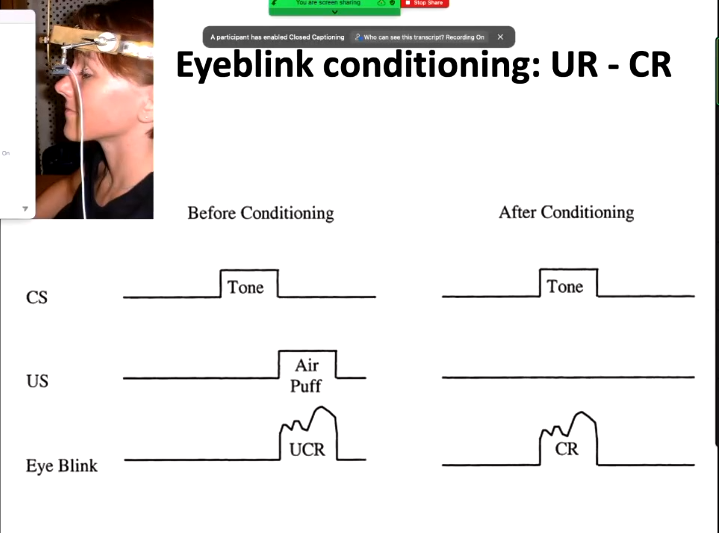
Lecture 2
What are the 3 stages of a typical classical conditioning experiment?
Stage 1: Habituation
Stage 2: Acquisition
Stage 3: Extinction
Lecture 2
Explain Stage 1 of a typical classical conditioning experiment
Stage 1: Habituation
CS presented alone
This is to see if the organism will respond in any why we have not expected or measured for
e.g. whistle alone is presented to dogs
Lecture 2
Explain Stage 2 of a typical classical conditioning experiment
Stage 2: Acquisition
CS presented along with US
This is to create the association for the organism
e.g. whistle with food presented to dogs → dogs salivate
Lecture 2
Explain Stage 3 of a typical classical conditioning experiment
Stage 3: Extinction
CS presented alone
This is to see if the assocation was created and successful (CR)
Can also be used in the example of phobias and to see if the organism still reacts to the CS alone
e.g. Dogs hear whistle → Dogs salivate
e.g. Human sees leaf pile → Human does not react with fear and the thoughts of a snake hiding inside
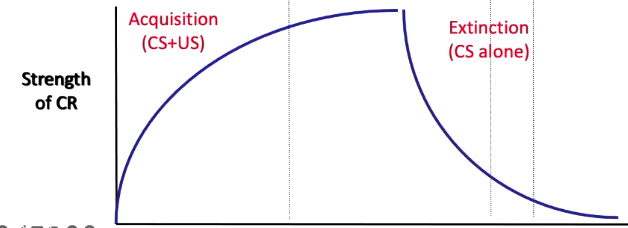
Lecture 2
Explain the attached graph.
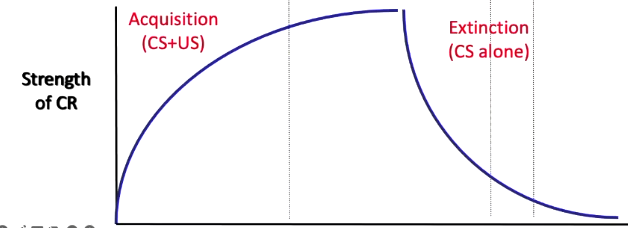
This graph illustrates a typical classical conditioning experiment, where there is an increase in CR strength over time due to the association between the US and the CS.
However, during the extinction stage, where the CS is presented alone, the strength of the CR slowly decreases as more trials are performed.
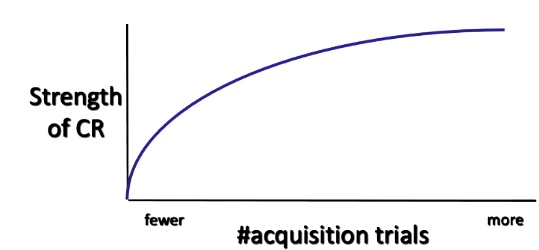
Lecture 2
What two factors can influence the acquisition curve of a typical classical conditioning experiment?
A more intense US can result in a stronger CR
e.g. a more flavourful food or more traumatc event
The order and timing
The CS coming before the US is better
Lecture 2
What is an Interstimulus Interval (ISI) in Stage 2 (Acquisition Phase) of a classical conditioning experiment?
The distance between the start of the CS and the start of the US
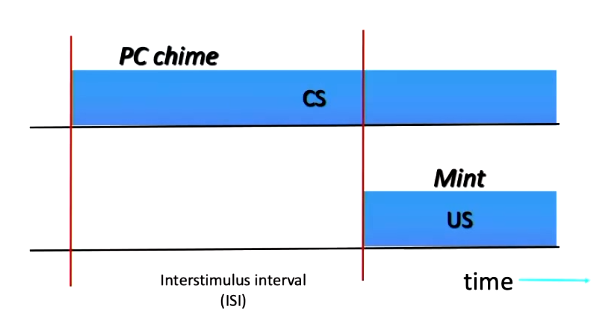
Lecture 2
What is a Delay Conditioning-Short layout in Stage 2 (Acquisition Phase) of a classical conditioning experiment?
CS presented first before US joins shortly after
e.g. Whiste plays by self first, food presented towards end of short whistling period
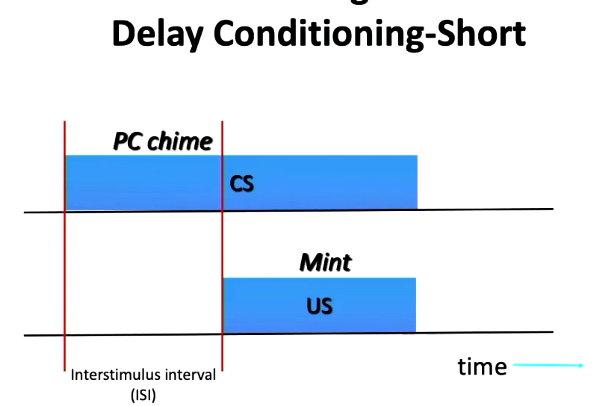
Lecture 2
What is a Delay Conditioning-Long layout in Stage 2 (Acquisition Phase) of a classical conditioning experiment?
CS presented first before US joins after a longer time
e.g. Whiste plays by self first, food presented towards end of long whislting period
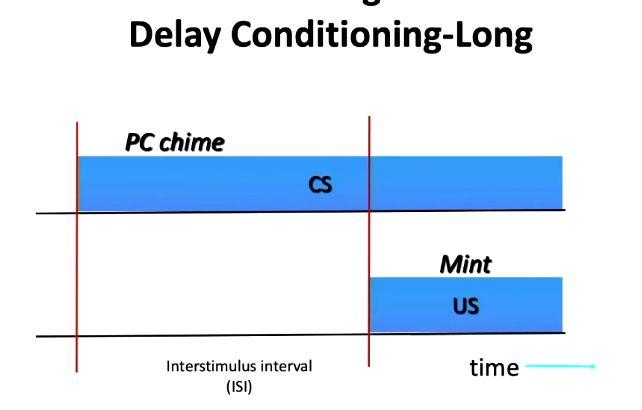
Lecture 2
What is the Trace Conditioning layout in Stage 2 (Acquisition Phase) of a classical conditioning experiment?
CS presented first by self, and after a small gap (trace interval), the US is presented by self
e.g. Play whistle by self, and after a small break deliever food by self
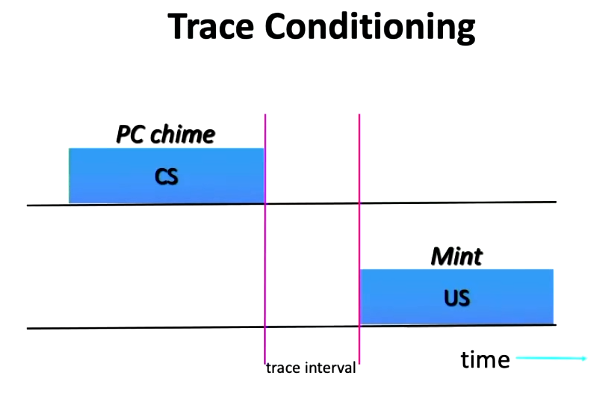
Lecture 2
What is the Simultaneous Conditioning layout in Stage 2 (Acquisition Phase) of a classical conditioning experiment?
CS and US delievered at same time
Food and whistle presented at the exact same time
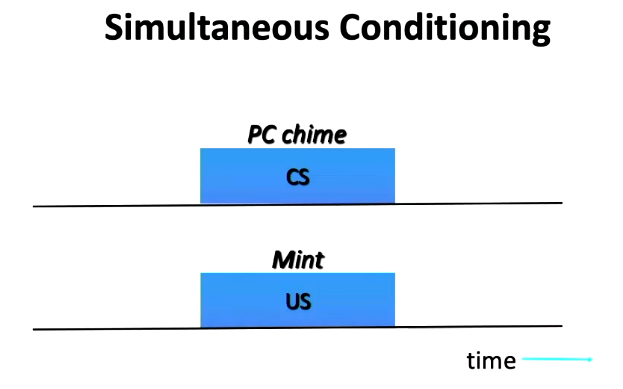
Lecture 2
What is the Backward Conditioning layout in Stage 2 (Acquisition Phase) of a classical conditioning experiment?
US presented before CS
e.g. Food is presented first before whistle
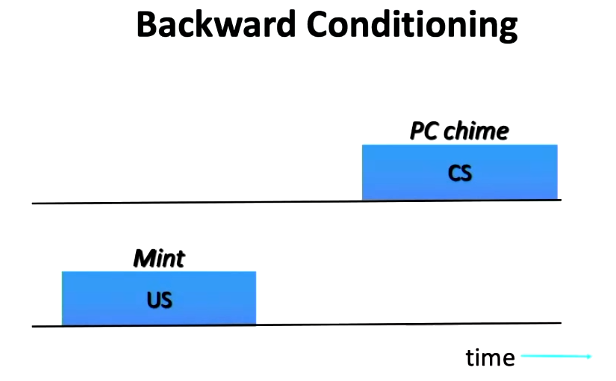
Lecture 2
What is the Temporal Conditioning layout in Stage 2 (Acquisition Phase) of a classical conditioning experiment?
CS presented at certain time of day that leads to US
e.g. Whistle is presented at certan time of day that leads to food
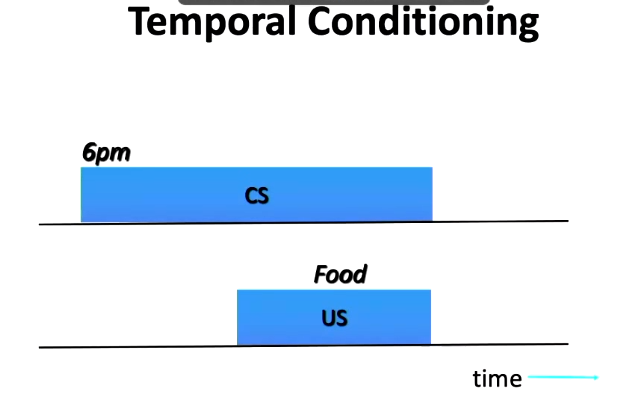
Lecture 2
Is the CS coming before the US considered more effective in learning?
The CS coming before the US is considered better as it makes the subject believe that A causes B, leading to quicker learning in associations
Lecture 2
What are the two types of Classical Conditioning?
Excitatory conditioning
Inhibitory conditioning
Lecture 2
What is Excitatory Conditioning?
CS predicts occurence of US
e.g. blowing whistle brings food
This leads to a CR
e.g. saliva
The organism has learnt that the CS leads to US
Lecture 2
What is Inhibitory Conditioning?
CS predicts absence of US
e.g. blowing whistle does not bring food
This leads to no CR
e.g. no saliva
The organism has learnt that the CS leads to no US
Lecture 2
What tests can be used to know if an animal exhibits inhibitory conditioning?
An inhibited organism must pass both the:
Retardation test
Summation test
Lecture 2
What is the Retardation Test?
Lecture 2
What is the Summation Test?
Lecture 2
What is the Spontaneous Recovery in Stage 3 (Extinction Phase) of a classical conditioning experiment?
Reintroduce CS after a small break, the CR reappears
e.g. Dog loses association between whistle and salivating, but after a small week break dog salivates again after hearing whistle
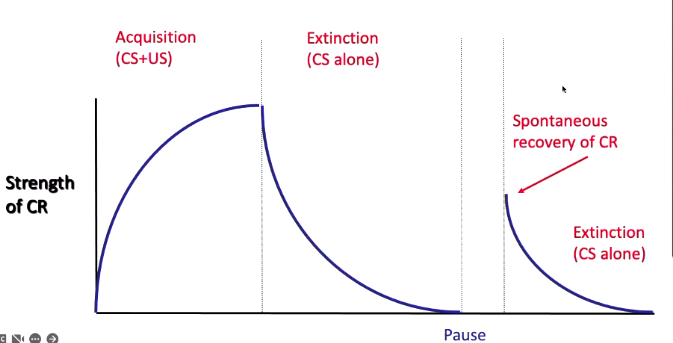
Lecture 2
What is the Renewal in Stage 3 (Extinction Phase) of a classical conditioning experiment?
When extinction is context specific
Dog gets acquisition between whistle and food in lab. Goes home and extinction occurs, whereby no salivation occurs at the sound of a whistle. However, dog goes back to lab and renewal occurs as salivation occurs at only sound of whistle = specific to location

Lecture 2
What is the Reinstatement (reminder effect) in Stage 3 (Extinction Phase) of a classical conditioning experiment?
Present US alone after extinction, CR appears after being ‘reminded’
After extinction, dog is presented only food and salivates. This reminds the dog that whistles also caused salivation, and so only whistling thereafter also causes CR
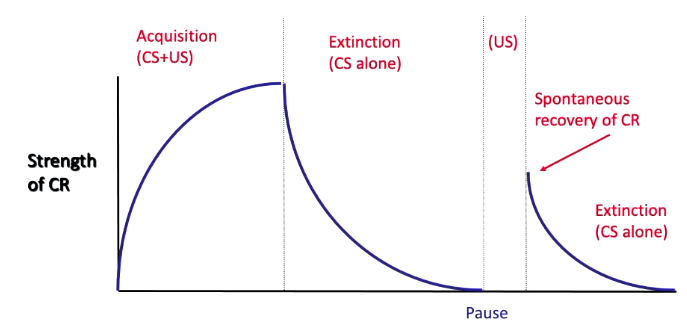
Lecture 2
What is blocking?
Blocking happens when learning about a new stimulus is blocked because another stimulus has already been learned to predict an outcome
e.g. Dog knows that bell → food. However, bell is later paired with a light, which leads to food. When the light is then shown by itself, the dog doesn’t salivate as the bell already predicts it.
The bell blocks the learning of the light-food connection
Lecture 2
What is Superconditioning?
The opposite of blocking → when a signal is learned strongly as it is a surprise and unexpected
e.g. Dog sees light, no food arrives. Dog later sees light with a bell played, which unexexpectedly brings food
Dog learns that bell means food will definitely come, as dog previously associated light with no food.
Lecture 4
Define operant conditioning
Operant conditioning relies on voluntary behaviours - the consequences of past behaviours affecting future responses
If a behaviour leads to a reward, it will become more frequent
If a behaviour leads to punishment, it will be repeated less
Lecture 4
What is Thorndike’s cat (1898) experiment?
Thorndike first introduced Operant Conditioning with his cat box experiment
He trapped his cat in a box. If it completed a simple puzzle (e.g. pressing a lever or pressing a button), it escaped and had the reinforcement reward of milk
Overtime, the cat became quicker in escaping the box, showcasing its voluntary learning experience overtime
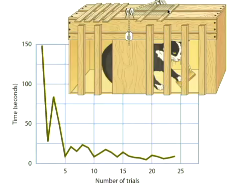
Lecture 4
Define shaping
A method to gradually teach a new behaviour by reinforcing successive approximations of the desired behaviour (gradually rewarding behaviours that are closer and closer to the final target behaviour)
e.g. giving a reward if animal is within 10cm of lever, to 5cm, to touching the lever and to finally pressing down on the lever
Lecture 4
Define baiting
Using food or another reward to lure an animal to a specific spot or position to encourage a desired behaviour.
e.g. placing food on a mat to get a dog to go and sit there.
Lecture 4
Define mimics
Reinforcing an animal when it copies or imitates human actions like sounds or movements.
e.g. giving a parrot food when it copies a word or dance move.
Lecture 4
Define sculpting
Physically guiding an animal to perform a behaviour, then reinforcing it so the animal learns to do it on its own.
e.g. moving a dog’s paw to press a button, then rewarding it.
Lecture 4
Define chaining
Teaching a complex behaviour by breaking it into smaller steps and reinforcing each step in sequence. In backward chaining, the last step is taught first and earlier steps are added one at a time.
e.g. teaching a child to brush their teeth by starting with reinforcing the last step (putting the toothbrush away), then adding earlier steps like rinsing, brushing, and applying toothpaste.
Lecture 4
Define bridging
Using a signal (like a sound or word) to mark the exact moment a correct behaviour happens, which “bridges” the time between the behaviour and the reward.
e.g. using a clicker sound the instant a dolphin jumps through a hoop, before giving a fish reward a few seconds later.
Lecture 4
Define Positive Reinforcement
Adds something to increase a desired behaviour
e.g. a treat for good behaviour
Lecture 4
Define Negative Reinforcement
Removes something to increase a desired behaviour
e.g. remove discomfort, get a day off work after performing well, etc.
Lecture 4
Define Positive Punishment
Adds something to decrease a behaviour
e.g. Shock collars, getting told off, etc.
Lecture 4
Define Negative Punishment
Removes something to decrease a behaviour
e.g. taking a phone away, losing your license, etc.
Lecture 4
What are the two schedules of reinforcement?
Continuous (CRF)
Partial (PRF)
Lecture 4
What is a continuous (CRF) schedule of reinforcement?
The animal is rewarded (or punished) every time it performs a specific behaviour.
e.g. a dog gets a treat every time it sits on command.
Lecture 4
What is a partial (PRF) schedule of reinforcement?
The animal is rewarded (or punished) only some of the time it performs the behaviour.
e.g. a dog only gets a treat sometimes when it sits on command.
Lecture 4
What are the four types of a partial (PRF) schedule reinforcement?
Ratio Schedule:
Fixed Ratio (FR)
Variable Ratio (VR)
Interval Schedule:
Fixed Interval (FI)
Variable Interval (VI)
Lecture 4
What is a ratio schedule?
Reinforcement is based on the number of times a behaviour occurs
Lecture 4
What are the two types of ratio schedules?
Fixed Ratio (FR)
Variable Ratio (VR)
Lecture 4
What is a Fixed Ratio (FR)?
The animal is rewarded after a set number of responses
e.g. a rat gets a treat every 10 times it presses a lever.
Lecture 4
What is a Variable Ratio (VR)?
The animal is rewarded after a random number of responses, around an average.
e.g. gambling – a win comes after a random number of plays on a slot machine
Lecture 4
What is an interval schedule?
Reinforcement is based on the amount of time passing
Lecture 4
What are the two types of interval schedules?
Fixed Interval (FI)
Variable Interval (VI)
Lecture 4
What is a Fixed Interval (FI)?
The animal is rewarded for the first correct behaviour after a set amount of time has passed
e.g. a dog gets a treat every hour if it sits, but only once per hour
Lecture 4
What is a Variable Interval (VI)?
The animal is rewarded for the first correct behaviour after a changing (random) amount of time.
e.g. a dog gets a treat for sitting, but the time between treats changes each time — sometimes after 2 minutes, sometimes after 5, etc.
Lecture 4
Is a ratio schedule or interval schedule considered more effective?
Ratio schedules are considered more efficient
Variable Ratios are seen as the most resistant to extinction because it teaches persistence
e.g. never stopping in gambling as you could be close to hitting it big

Lecture 4
Is a continuous (CRF) schedule of reinforcement or partial (PRF) schedule of reinforcement better?
Continuous is more effective then partial as the animal learns every single time the behaviour occurs
Lecture 4
Is reinforcement or punishment considered more effective?
Reinforcement is seen as more effective and produces more desirable behaviours in animals more quickly
Punishment isn’t as permanent, reduces trust & increases aggression
Lecture 4
What are the three other reward variables that can influence behaviour learning?
Drive
Size
Delay
Lecture 4
What is drive?
Reinforcement depending on how much the organism wants the reinforcer
e.g. a hungry dog really wanting a treat vs a full dog not as desperate to have a treat
Lecture 4
What is size?
Reinforcement depending on how much of the reinforcer the organism receives
e.g. a dog is more likely to perform the desired behaviour if they will receive more treats
Lecture 4
What is delay?
Reinforcement depending on if the organism receives the reinforcer immediately or later
e.g. a dog is more likely to perform a behaviour again if it receives a treat immediately after
Lecture 4
When do reinforcers work better?
Reinforcers work better when:
When the drive is higher,
The reinforcer is larger
The reinforcer is given right away